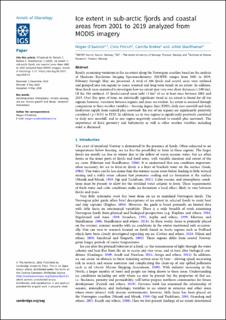| dc.contributor.author | O'Sadnick, Megan Eileen | |
| dc.contributor.author | Petrich, Chris | |
| dc.contributor.author | Brekke, Camilla | |
| dc.contributor.author | Skardhamar, Jofrid | |
| dc.date.accessioned | 2020-09-15T11:31:13Z | |
| dc.date.available | 2020-09-15T11:31:13Z | |
| dc.date.created | 2020-06-18T11:13:13Z | |
| dc.date.issued | 2020 | |
| dc.identifier.citation | Annals of Glaciology. 2020, . | |
| dc.identifier.issn | 0260-3055 | |
| dc.identifier.uri | https://hdl.handle.net/11250/2677840 | |
| dc.description | © The Author(s), 2020. Published by Cambridge University Press. This is an Open Access article, distributed under the terms of the Creative Commons Attribution licence (http://creativecommons.org/licenses/by/4.0/), which permits unrestricted re-use, distribution, and reproduction in any medium, provided the original work is properly cited. | |
| dc.description.abstract | Results examining variations in the ice extent along the Norwegian coastline based on the analysis of Moderate Resolution Imaging Spectroradiometer (MODIS) images from 2001 to 2019,February through May, are presented. A total of 386 fjords and coastal areas were outlined and grouped into ten regions to assess seasonal and long-term trends in ice extent. In addition,three fjords were examined to investigate how ice extent may vary over short distances (<100 km). Of the 386 outlined, 47 fjords/coastal areas held >5 km2 of ice at least once between 2001 and 2019. Over this span of time, no statistically significant trend in ice extent is found for all ten regions; however, variations between regions and years are evident. Ice extent is assessed through comparison to three weather variables – freezing degree days (FDD), daily new snowfall and daily freshwater supply from rainfall plus snowmelt. Six out of ten regions are significantly positively correlated ( p < 0.05) to FDD. In addition, ice in two regions is significantly positively correlated to daily new snowfall, and in one region negatively correlated to rainfall plus snowmelt. The importance of fjord geometry and bathymetry as well as other weather variables including wind is discussed. | |
| dc.language.iso | eng | |
| dc.rights.uri | http://creativecommons.org/licenses/by/4.0/ | |
| dc.subject | Sea ice | |
| dc.subject | Sea ice | |
| dc.subject | Ice atmosphere interactions | |
| dc.subject | Ice/atmosphere interactions | |
| dc.subject | Ice ocean interactions | |
| dc.subject | Ice ocean interactions | |
| dc.subject | Sea-ice growth and decay | |
| dc.subject | Sea-ice growth and decay | |
| dc.title | Ice extent in sub-arctic fjords and coastal areas from 2001 to 2019 analyzed from MODIS imagery | |
| dc.type | Peer reviewed | |
| dc.type | Journal article | |
| dc.description.version | publishedVersion | |
| dc.subject.nsi | VDP::Annen marin teknologi: 589 | |
| dc.subject.nsi | VDP::Other marine technology: 589 | |
| dc.source.pagenumber | 17 | |
| dc.source.journal | Annals of Glaciology | |
| dc.identifier.doi | 10.1017/aog.2020.34 | |
| dc.identifier.cristin | 1816115 | |
| dc.relation.project | Norges forskningsråd: 237906 | |
| cristin.ispublished | true | |
| cristin.fulltext | original | |
| cristin.qualitycode | 1 | |

